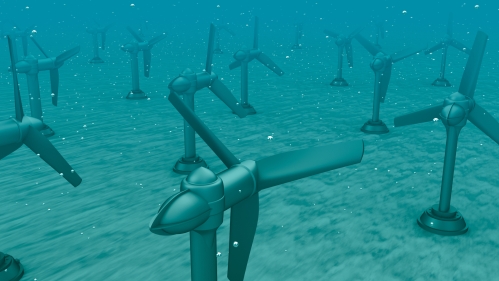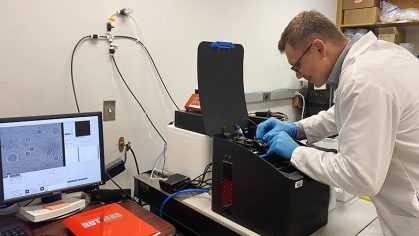After completing a theoretical project that modeled offshore wind turbines, School of Engineering researchers have received a new Department of Energy grant to convert theory into practice by developing and testing novel hydrokinetic turbine (HKT) designs.
Onur Bilgen, an associate professor in the Department of Mechanical and Aerospace Engineering, and Ruo-Qian (Roger) Wang, an assistant professor in the Department of Civil and Environmental Engineering, are co-principal investigators (co-PIs) in a collaborative project funded by a $3.9 million grant from the U.S. Department of Energy’s Advanced Research Projects Agency-Energy (ARPA-E).
Their project, RAFT: Reconfigurable Array of High-Efficiency Ducted Turbines for Hydrokinetic Energy Harvesting, is one of 10 projects receiving a combined total of $38 million in funding to develop new technologies for underwater turbine systems.
The multi-disciplinary, multi-university team received this award from ARPA-E’s Submarine Hydrokinetic and Riverine Kilo-megawatt Systems, or SHARKS, program. Led by the University of Michigan, the collaborative team of faculty experts, funded graduate research assistants, and post-doctoral researchers will combine control co-design and ducted distributed direct-drive concepts to develop novel HKT designs. Their designs will be able to generate electricity efficiently while reducing manufacturing, maintenance, and operational costs.
A Key Role for Rutgers
“This is certainly one of the most exciting topics I’ve worked on in my career,” says Bilgen.
“I’m truly passionate about our designs, and upcoming theoretical and experimental work – and I’m proud of Rutgers’ key role in the project.”
Bilgen and MAE colleague assistant professor Laurent Burlion, were previous recipients of an AARPA-E Aerodynamic Turbines Lighter and Afloat with Nautical Technologies and Integrated Servo-control (ATLANTIS) program grant focused on modeling offshore wind turbines, or wind farms, using the discipline of control co-design.
Bilgen sees SHARKS as a nice follow up to ATLANTIS, which was purely theoretical. His research team will lead conceptual design, structural modeling, analysis, and design optimization efforts. “We’re focusing on hydrokinetic turbines -- we’ll have manufacturing, experiments, and demonstrations for proof of concepts and model validation,” he notes.
Wang, who is the project’s lead environmental impact expert, will study the project’s environmental impact, as the successful interaction between the environment and a hydrokinetic power plant is critical to the SHARKS project’s success – and the development of a feasible plan for eventual commercialization.
Making Hydrokinetic Power Affordable
The SHARKS project is specifically aimed, according to ARPA-E, to address industry-wide limitations to provide economical hydrokinetic power at micro-grid and utility scale.
“There is an immense amount of consistent energy in water,” explains Bilgen. “Yet while water gives life, it is also very good at destroying machines, which is why energy from water can be extremely expensive.”
According to Bilgen, typical hydroelectric power stations with large dams that changes everything upstream and downstream, the project’s proposed designs should be gentler, as they do not rely on blocking the entire or a large portion of the stream.
These designs are unique, he adds, since they are “purposefully simple, consisting of small, repeated units. Instead of making big, complicated and expensive HKTs, we propose a clever collection of cheap, simple and small HKTs. This approach of using mechanically simple devices in larger quantities is mainly how other commercial products, such as drones and phones, became successful.”
The professors, who expect at least four students and one postdoctoral candidate will be engaged with the project, have high hopes for success. “I believe our designs have a real chance of reducing the cost of energy, and of making tidal and riverine energy harvesting as common as hydroelectric or carbon-fuel based energy systems,” predicts Bilgen. “Our designs will make renewable energy systems highly competitive.”



